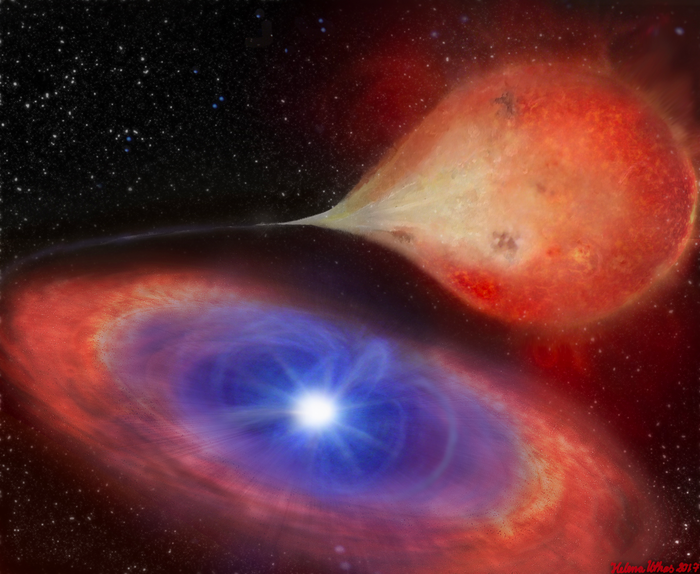For the first time, using a planet-hunting satellite, astronomers have observed a white dwarf abruptly turning on and off.
 An artist’s impression example of a white dwarf — in this image the white dwarf MV Lyrae — accreting as it draws in material from a companion star. (Image Credit: Helena Uthas)
An artist’s impression example of a white dwarf — in this image the white dwarf MV Lyrae — accreting as it draws in material from a companion star. (Image Credit: Helena Uthas)
The scientists led by Durham University, UK, used NASA’s Transiting Exoplanet Survey Satellite (TESS) to study the unique occurrence.
White dwarfs are basically what stars become when they have depleted the hydrogen that fuels them. They are about the size of the Earth and have a mass that is closer to that of the Sun.
The white dwarf seen by the astronomers is said to be accreting or feeding, from an orbiting companion star. Astronomers saw it lose brightness in 30 minutes during these new observations. Earlier, this process was only seen to take place in accreting white dwarfs over a period of many days to months.
The brightness of an accreting white dwarf is influenced by the amount of surrounding material it feeds on, so the scientists conclude something is impacting its food supply.
They anticipate the discovery will help them understand more about the physics underlying accretion — where objects like black holes, neutron stars and white dwarfs feed on adjacent material from neighboring stars.
The findings have been reported in the Nature Astronomy journal.
The team witnessed the occurrence in the white dwarf binary system, TW Pictoris, which is located approximately 1,400 light-years from Earth.
TW Pictoris has a white dwarf that feeds on a surrounding accretion disk powered by helium and hydrogen from its smaller companion star. As the white dwarf eats — or accretes — it turns brighter.
Using the accurate observational detail provided by TESS — typically used to hunt for planets outside the solar system — the Durham-led team witnessed sudden falls and rises in brightness never before observed in an accreting white dwarf on such short timescales.
Since the material flow onto the white dwarf’s accretion disk from its companion star is fairly constant, it should not radically impact its luminosity on such short timescales.
Instead, the scientists are certain that what they observed could be reconfigurations of the surface magnetic field of the white dwarf.
In the “on” mode, when the brightness is high, the white dwarf eats off the accretion disk as it generally would. Unexpectedly and abruptly the system switches “off” and its brightness drops.
The team states that when this occurs, the magnetic field is spinning so fast that a centrifugal barrier halts the fuel from the accretion disk continuously falling onto the white dwarf.
During this period, the amount of fuel the white dwarf can feed on is being controlled via a process known as magnetic gating.
Here, the spinning magnetic field of the white dwarf controls the fuel traveling via a “gate” onto the accretion disk, causing semi-regular small increases in brightness witnessed by the astronomers.
After a while, the system intermittently switches “on” again, and the brightness increases back to its former level.
The brightness variations seen in accreting white dwarfs are generally relatively slow, occurring on timescales of days to months. To see the brightness of TW Pictoris plummet in 30 minutes is in itself extraordinary as it has never been seen in other accreting white dwarfs and is totally unexpected from our understanding of how these systems are supposed to feed through the accretion disc. It appears to be switching on and off.
Dr. Simone Scaringi, Study Lead, Centre for Extragalactic Astronomy, Durham University
“This really is a previously unrecognised phenomenon and because we can draw comparisons with similar behaviour in the much smaller neutron stars it could be an important step in helping us to better understand the process of how other accreting objects feed on the material that surrounds them and the important role of magnetic fields in this process,” he added.
Compared to neutron stars, white dwarfs are more common in the Universe. Therefore, astronomers hope to hunt for other examples of this behavior in future research ventures to gather more details about accretion.
The research received funding from Durham University (UK). The research team also included the South African Astronomical Observatory; Radboud University (The Netherlands); the University of Cape Town and the University of the Free State (South Africa); the University of Southampton (UK), the Italian National Institute for Astrophysics and the University of Notre Dame (United States).
Journal Reference:
Scaringi, S., et al. (2021) An accreting white dwarf displaying fast transitional mode switching. Nature Astronomy. doi.org/10.1038/s41550-021-01494-x.